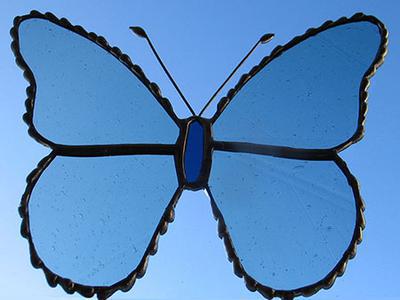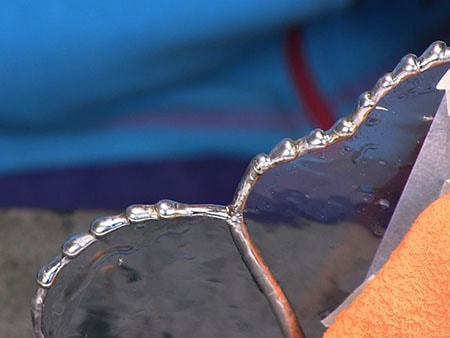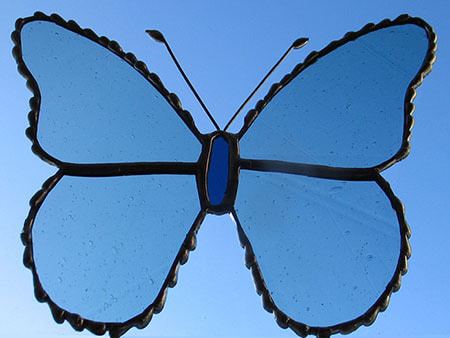Pretty Dripped Solder Edge
Decorative soldering for stained glass is the difference between a Victoria sponge and a Wedding Cake. It really is special and adds that ‘WOW’ factor to your projects. You can go from ‘Victoria sponge to Wedding Cake’ by downloading this video tutorial right now.
Decorative soldering for stained glass is the next logical step if you’ve got to the point where you’re confident with soldering but you want to lift your artistry to another MUCH higher level. It’s surprising how much difference a few drips make, you’ll be amazed!
Decorative Soldering Method
Before You Start Decorative Soldering
- I use 60/40 solder and a Weller 100 with a 700F 1/4″ tip. This suits my way of working but you might find that a different combination is better for you. Some people swear by 63/37 solder for decorative soldering for stained glass. I find that for this technique I need the extra fraction of a second that 60/40 allows me to let the drip run. Feel free to try 63/37 and see which one works best for you.
- Make sure you have a protective glove for your non-soldering hand and some pegs to hold the sun catcher.
- As always, adequate ventilation and safety glasses are essential. If you’re not sure about how to keep safe when stained glassing then read my health and safety suggestions here.

Balance and Gravity
The technique is all about balance and gravity. You need to balance the solder drip on top of a horizontal foiled edge while making sure that the butterfly is kept on a vertical plane. Then you use gravity to make the drip run but if you tip the butterfly forwards out of balance the drip will fall forward. Find out how to control this balancing act in the video.
It’s also a balance between how much solder and flux to use. Too much of either and the solder will roll off in an uncontrolled fashion. Too little and the drips won’t be big enough and will just look like a wavy line.

Getting Started with Decorative Soldering
- It doesn’t seem logical but start the decorative soldering drips at the BOTTOM of the wing and work upwards towards the middle of the butterfly.
If you do it this way you won’t be melting the drip you’ve just done and you’ll have space for your next drip - Flux your foiled edge and hold it horizontally
- Pick up a drip of solder on your iron tip and place it carefully on the foiled edge.
If you can’t get a drip of solder on to the iron tip then your iron is at the incorrect temperature. Turn it down if it’s falling off and up if it’s not picking up). - Now heat the drip up until it goes shiny and wants to run
- Carefully start tipping down – still keeping the butterfly on a vertical plane – while heating and nudging with the tip of the iron. This is quite tricky to explain in words and best described by watching the video
- The drip should run along the top of the edge and stop when it starts to set

Your Second Drip
- After a couple of seconds the solder colour dulls and you’re ready to start your next decorative soldering drip
- Start it about 1/2 inch from the last drip. If start another one too close the drips will merge into a wavy line. This can end up looking like bad soldering rather than a gorgeous edge! This is your artistic decision though. The gap between the drips is a decision you make that affects how the end result turns out. You might WANT wavy lines or large gaps in between the drips. This is perfectly fine!
- Repeat the above steps for each drip until you reach the middle seam
- Then go back to the bottom and work you way up the inside of the wing to the ‘body’ of the butterfly. (What ARE they called?)
Get the Drippy Soldering video here
“I made my first decorative solder butterfly after watching your video and it was so beautiful that I gave it away as a gift. I love the technique and cannot wait to create something else.” Annie Dugan on the Drippy Soldering video
Finishing Up
- Once you’ve done the decorative soldering along each edge, touch up any solder areas that have been disturbed by the drips
- Wash and polish the butterfly as you would normally. You can use Kwik Clean or read my page on Patina and Polish if you’re not sure how to get a sparkle to your finished projects.
- Patina is optional as always. I left this butterfly silver as I liked the more subtle effect.

This particular decorative soldering technique for stained glass it’s not the easiest thing to get right. It takes a lot of patience at the beginning and a lot of drips that have gone astray! But it is truly worth the effort as I hope you can see for yourself.
Good luck and let me know how you get on. If you are finding it a bit too tricky, how about perfecting your Beaded Edges first and then coming back later to give it another try?
Want more decorative techniques? Look at this page on stained glass overlay.
Return to the Everything Stained Glass Home Page


MAYBE A GOOD SUBJET IS REPAIR
HOWTO REMOVE LEAD BAR
howto desoldering whit a electronic desoldering poumb
and cleaninf trick
etc
Thanks for the ideas Jacques, I’ll have a think.
Any ideas to make eyes for dog and cat sun catchers? It’s hard to cut and can’t show the pupils..
Thanks a lot!
There are some wire working ideas here Kimmie: https://everythingstainedglass.com/wire-spiral-tutorial#wireeyes
And/or you can use fire-in-the-oven semi permanent paint like Pebeo 160.
I hope that helps.
A million thanks Miss Milly for sharing your expertise in everything stained glass for free! I did enroll in one of your classes and most likely will again in the future. For now, I have a question. I have a Weller 100W with many size soldering tips and I just bought your recommended HakkoFX-601. Since I have so many Weller tips, is it interchangeable with the Hakko iron or do I need to buy specific Hakko tips?
Good question but sadly the answer is ‘no’. You’ll have to buy dedicated Hakko 601 tips. The Weller tips are temperature controlled which is a totally different system to the Hakko dial. I hope that helps.
Thanks too for your kind words Gloria, I’m glad you liked my online classes.
This is a related decorative solder question, but not edge-focused.
I know that there exists “scalloped” copper foil, for adding a wavy line at the edges (or wherever the scalloped foil is positioned and fluxed) as you solder.
I have “decorative” scissors that cut zig-zag lines — like pinking shears, but for paper, not fabric, and in a few different “zigzag” dimensions (pointier, wider, more square, etc.). If I cut copper foil using them, and attach these fancy strips to my glass (say I’m doing a small holiday tree and these represent garland), will the solder follow the zig-zags? Or will it have a tendency to round out, and just look blobby?
(I will experiment anyway because I’m curious, but I just wondered if this is something others have tried and abandoned for good reason. Maybe the scalloped edge is as fancy as solder wants to get?)
Thanks again for all your advice and information on these pages!
Good creative thinking April. You can cut all sorts of shapes and patterns with the foil and, as long as you just tin it with a minimal amount of solder, it will retain it’s sharp edges. I have a page on foil overlay here that’ll help you: https://everythingstainedglass.com/stained-glass-overlay
How do you add wire lite legs and spirals to projects?
If you use wire that you can solder to you hold them in place with pliers and solder to a seam. If you want them to be the same colour as your patina, tin and patina the wire first before soldering. Clean and touch up the join afterwards.
Just what I needed when I needed it. You are magical.
I’ve been called a few things but never magical 🙂 Thanks Judith; I’m happy that the timing was right for you.
Hi Milly just watched your super vides of beading outer edge. Jane you any advice for a newbie, I have a newish weller 100 iron thermostatically controlled tip so unable to turn down the temp I’ve used 60/40 solder and 50/50 solder but it’s still unsatisfactory. Any helpful advice would be gratefully recieved thank you .
Hi Su, soldering stained glass is a balance of heat and time, so you could try speeding up. If this isn’t an option you can always unplug the iron temporarily and work for a few minutes while it’s at a lower heat, then plug it in again. Not ideal but at least you’ll get to know whether the heat is the problem.